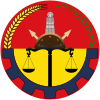
Back Tigray-streek Afrikaans ትግራይ ክልል Amharic إقليم تغراي Arabic تيجراى ARZ Rehiyon Tigray BCL Тыграй Byelorussian Тиграй (регион) Bulgarian Tigrae Breton Tigre (regió) Catalan Tigraj Czech
This article needs additional citations for verification. (December 2022) |
Tigray Region
ክልል ትግራይ | |
|---|---|
| Tigray National Regional State | |
| Nickname: The birthplace of Ethiopian civilization | |
| Motto(s): "ዘይንድይቦ ጎቦ ዘይንሰግሮ ሩባ" "There are no mountains we would not climb" | |
 Map of Ethiopia showing Tigray Region | |
| Coordinates: 14°7′28″N 38°43′26″E / 14.12444°N 38.72389°E | |
| Country | Ethiopia |
| Capital | Mekelle |
| Government | |
| • Chief Administrator | Getachew Reda |
| Area | |
• Total | 53,036 km2 (20,477 sq mi) |
| • Rank | 5th |
| Population (2020)[2] | |
• Total | 7,070,260 |
| • Rank | 4th |
| • Density | 130/km2 (350/sq mi) |
| Demographics | |
| • Official language | Tigrinya |
| • Demonym | Tigrayan |
| Time zone | UTC+3 (EAT) |
| ISO 3166 code | ET-TI |
| HDI (2021) | 0.522 [3] low · 5th of 11 |
| Website | www |
The Tigray Region[A] (or simply Tigray; officially the Tigray National Regional State)[B] is the northernmost regional state in Ethiopia. The Tigray Region is the homeland of the Tigrayan, Irob and Kunama people. Its capital and largest city is Mekelle. Tigray is the fifth-largest by area, the fourth-most populous, and the fifth-most densely populated of the 11 regional states.
Tigray is bordered by Eritrea to the north, the Amhara Region to the south, the Afar Region to the east, and Sudan to the west.[4] Towns in Tigrai include: Mekelle, Adigrat, Axum, Shire, Adwa, Humera, Dansha, Mai Kadra, Enticho, Feresmay, Wukro, Agula'e, Freweyni, Korarit, Adi Daero, Ketema Ngus, Adi Remets, Sheraro, Abiy Addi, Atsbi, Hawzen, Adi Gudom, Adi Shu, Chercher, Korem, Maychew, Alamata, Mekoni, Rama, May Tsebri, Addi Remets, Hagere Selam,Dowhan and Zalambessa.
Tigray's official language is Tigrinya, similar to that of southern Eritrea. The Tigray region had an estimated pre-war population of 7,070,260.[5] The majority of the population (c. 80%) are farmers, contributing 46% to the regional gross domestic product (2009). The highlands have the highest population density, especially in eastern and central Tigray. The much less densely populated lowlands comprise 48% of Tigray's area. Although the percentage of Muslims in Tigray is less than 5%, it has supposedly been historically Islam's doorway to the region and to Africa at large.[6] 96% of Tigrayans are Orthodox Christian. After Armenians, ethnic Tigrayans have the highest percentage of Orthodox Christians in the world.
The government of Tigray consists of the executive branch, led by the president, Getachew Reda; the legislative branch, which comprises the state council; and the judicial branch, which is led by the state supreme court. In early November 2020, a conflict between the Tigray People's Liberation Front (TPLF) and the Ethiopian federal government (with support from Eritrea)[7] rapidly escalating into the Tigray War, destabilizing the region,[8] and exposing a well-organized campaign to wipe out the region of ethnic Tigrayans.[9] As many as 600,000 people were killed as a result of the war.[10][11][12] As of 2023, the region is run by the Interim Regional Administration of Tigray.
- ^ Cite error: The named reference
2006_statswas invoked but never defined (see the help page). - ^ Situation Analysis of Children and Women: Tigrau Region (PDF) (Report). 1 December 2019. Archived (PDF) from the original on 9 July 2021. Retrieved 23 December 2021.
- ^ "Sub-national HDI – Area Database – Global Data Lab". hdi.globaldatalab.org. Archived from the original on 23 September 2018. Retrieved 10 September 2020.
- ^ Eritrea and Ethiopia (Map). 1:5,000,000. Central Intelligence Agency. 2009. Map #803395. Archived from the original on 22 October 2013. Retrieved 5 May 2011.
- ^ "New study of Tigray – violence and casualties during the war and after". Martin Plaut. 22 July 2024. Retrieved 7 December 2024.
- ^ Mellse, Merhawit (31 July 2021). "Tigray in History: A Pioneer of Religious Coexistence". Omna Tigray. Archived from the original on 11 December 2022. Retrieved 11 December 2022.
- ^ "Eritrean forces killed 100s of civilians in Tigray 'rampage': HRW". Al Jazeera. Archived from the original on 7 March 2021. Retrieved 25 May 2021.
- ^ "Tigray crisis: Ethiopia orders military response after army base seized". BBC News. 4 November 2020. Archived from the original on 19 November 2020. Retrieved 25 May 2021.
- ^ "Ethiopian leaders said they would 'wipe out' Tigrayans: EU envoy". www.aljazeera.com. Archived from the original on 30 June 2021. Retrieved 8 January 2023.
- ^ York, Geoffrey (21 October 2022). "Surge of dehumanizing hate speech points to mounting risk of mass atrocities in northern Ethiopia, experts say". The Globe and Mail. Archived from the original on 22 October 2022. Retrieved 8 January 2023.
- ^ Volodzko, David (10 May 2022). "There's Genocide in Tigray, but Nobody's Talking About it". ISSN 0027-8378. Archived from the original on 8 January 2023. Retrieved 8 January 2023.
- ^ Ochab, Dr Ewelina U. "Heightened Risk Of Genocide Against Tigrayans In Ethiopia". Forbes. Archived from the original on 8 January 2023. Retrieved 8 January 2023.
Cite error: There are <ref group=upper-alpha> tags or {{efn-ua}} templates on this page, but the references will not show without a {{reflist|group=upper-alpha}} template or {{notelist-ua}} template (see the help page).

